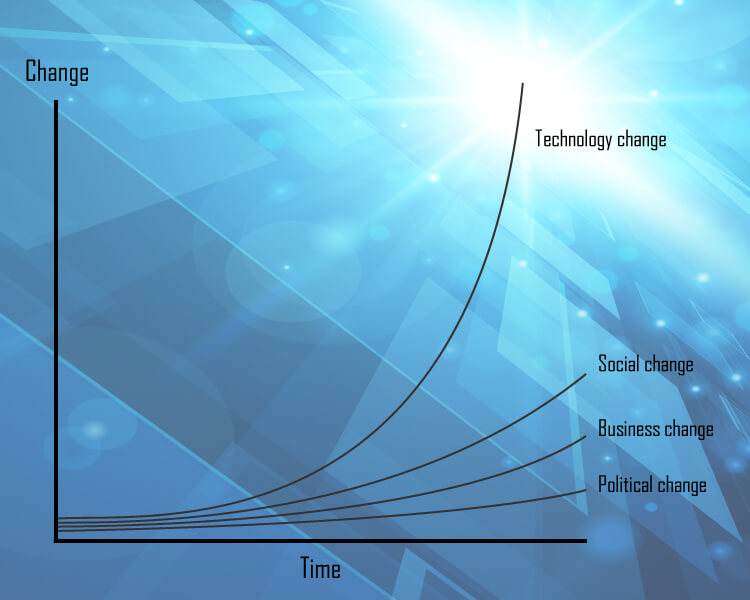
2050
Humanity is at a crossroads
The world of 2050 is a world of contrasts and paradoxes. On the one hand, science and technology have continued to advance in response to emerging crises, challenges and opportunities. This has created radical transformations in genetics, nanotechnology, biotechnology and related fields. On the other hand, many of these same technologies have been so disruptive that it has led to a more frightening, unpredictable and chaotic world than ever before. Humanity is now at a crossroads that will determine its future path for centuries to come – survival or destruction, prosperity or collapse.
Some of the most cherished political, economic and social structures have been turned on their heads. In a sense, capitalism remains the dominant economic model, but is now evolving drastically in response to ecological impacts,* resource scarcity,* demographic trends,* technology* and a host of other factors.* The endless consumer culture that was prevalent throughout the first world has all but collapsed, replaced by a societal need to conserve.* Though there are still many wealthy people around, money is concentrated in a shrinking upper class. By 2050, “traditional” free market capitalism is largely viewed as a broken system.***
As more and more wealth trickles upwards to the hyper-rich elite, there is a growing consensus that money itself – the profit motive – is a major obstacle to future progress, and a new driving force may be required for civilisation to flourish. Debates are raging on what reforms to make in order to adapt societies to this rapidly changing world. People everywhere sense that a great transition is approaching, the likes of which has never been seen before in all of human history.* It is clear that some new global paradigm will appear; but it is still unclear what this will be.

Decades of stagflation have produced a fragmented, chaotic and perpetually sluggish global economy. Nearly half of the world’s nations have “junk” credit ratings, effectively making them bankrupt.* US national debt has now reached almost 400% of GDP,* far exceeding even the levels seen during World War II. China and India, though surpassing the US in overall GDP,* have also stagnated.
In the face of economic catastrophe, international politics has faced enormous challenges. Although the number of democratic countries has risen significantly over the years,* many have turned inward, cutting off foreign relations. Revolutions, wars and failed states have produced a strikingly different geopolitical map than seen at the beginning of the century. To repair and maintain the fabric of society, an increasing number of regions have abandoned their national currencies in favour of interest-free, non-fiat, non-inflationary local ones.* Decentralised cash systems such as the Bitcoin* and other electronic alternatives have also exploded in use.
Social systems are under extraordinary stress today. The younger generations are increasingly resentful towards the elderly – seeing them as the cause of many problems, and a drain on capital as the ratio of workers to seniors continues to fall.** The rich and poor have continued to grow apart, now that upward social mobility has become next to impossible. Massive protests outside corporate HQs and gated communities are a daily reality on the news. Global warming has created almost 150 million climate refugees: a sixfold increase compared to 2010.* The influx of people to foreign lands has put a further strain on economies. Resentment towards migrants has produced an upsurge in nationalism with many isolationist parties sweeping government elections. To maintain order and stability, martial law and military occupation is a feature of many cities around the globe. Radical new political parties and movements have emerged, advocating the overthrow of the reigning system.
Recycling and waste management – for decades neglected by many countries* – are among the issues now taking centre stage.* New regulations and market pressures have forced corporations to move away from the model of planned obsolescence** and mass production, to one of conservation and responsibility. Most firms no longer sell entirely new models of their products when technological advances are made. Instead, replacement components and upgrades form the bulk of profits, with items made of universally interchangeable parts. In a world of increasing resource conflicts, “doing more with less” has become an essential mantra.* A system is also employed whereby customers return products at the end of their life cycle, to be used as materials for the next generation. In some of the worst-hit countries, mandatory resource dumps are organised, in which citizens are obligated to recycle any unnecessary possessions. Naturally such systems are highly controversial and intrusive.
Meanwhile, the widespread use of robots,* automation,* 3D printing* and other technology has rendered obsolete many traditional human roles. Though industries have made vast improvements in speed and efficiency, it has come at the expense of a declining labour force. Consequently, overall government revenues have seen a net reduction.

Radical Islam and its resentment of the West continue to produce new Jihadists. In addition, underground groups ranging from those angry at the first world’s neglect, to anarcho-primitivists, have sprung up. By 2050, at least one terrorist nuclear attack on a major world city has been conducted by one of these groups. Large amounts of nuclear material had been missing from Russia since the 1990s and some inevitably fell into the wrong hands.* Being orders of magnitude greater than 9/11, the effects of this attack leave a deep psychological scar on many people alive today, fuelling much paranoia and suspicion between nations.
Despite this turmoil, progress has been achieved in cooperating on certain key issues, such as global warming. Carbon emissions have fallen substantially compared with 1990 levels,* thanks to a global carbon tax* and the widespread deployment of solar, wind and wave power,* together with 4th generation nuclear.* Fossil fuel reserves were declining in any case.** Fusion power is also becoming available now* and is being adopted by some of the leading nations. Orbital solar is another emerging industry.* Energy efficiency and conservation have provided further reductions in CO2 output.
However, carbon emissions from earlier decades remain locked into the system. This delayed reaction will continue to affect weather patterns and climate stability,* as will the ongoing destruction of the Earth’s rainforests, some of which are transitioning from carbon sinks to carbon sources. Sea levels have risen over a foot by now* and are beginning to affect much of the world’s coastal real estate. Large-scale carbon capture and sequestration** appears to be humanity’s last and only hope of reversing these trends.

Nearly half of the Amazon rainforest has been deforested
Lack of
enforcement in the so-called protected areas has resulted in the Amazon
undergoing a catastrophic decline. Though army troops were sent into
regions of illegal deforestation, their numbers were simply
too small, and the Amazon too vast, to have sufficient impact. Political corruption also played a role in undermining protection efforts. Droughts
caused by global warming have further contributed to the decline, with many areas of jungle being turned into parched scrubland. By 2050, nearly 2.7 million sq km have been deforested.*
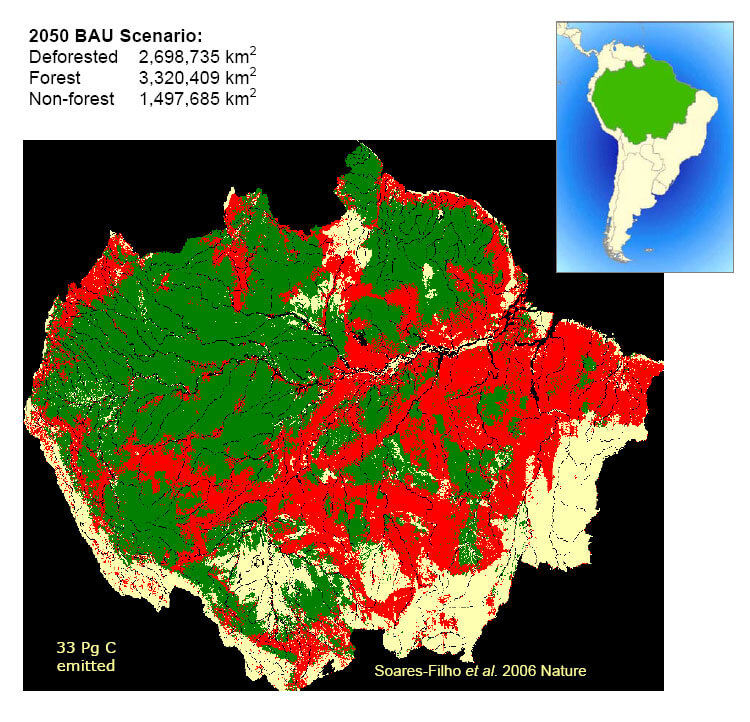
As a result,
over 30 billion tons of carbon have been added to the atmosphere.
Although clean energy sources are offsetting this,
they can’t save the countless species of plant and animal life
dependent on the rainforest for survival. Substantial amounts of biodiversity
have been lost. Desperate efforts are being made by non-profit organisations
to obtain DNA samples, in the hope of resurrecting these species at
some point in the future.

Above: A
red-eyed tree frog
Wildfires
have tripled in some regions
Rising
global temperatures are creating drier conditions for vegetation – producing
larger and more frequent wildfires. In North America, the geographic
area typically burned has increased by an average of 50%. Worst hit
are the forests of the Pacific Northwest and the Rocky Mountains, which
have seen a tripling of areas affected.*
With so
much extra burning, air quality and visibility in the western
United States is being significantly altered. There has been a 40% rise in organic
carbon aerosols and other smoke particles. These irritate the lungs, but are especially dangerous to people who
have trouble breathing as a result of asthma and other chronic conditions. Southern
Europe is also badly affected – especially Greece, which has
been ravaged in recent decades.*
These wildfires
are triggering positive feedback loops. As more and more
carbon is liberated from burning material and released into the atmosphere, this is further accelerating the pace of global warming.
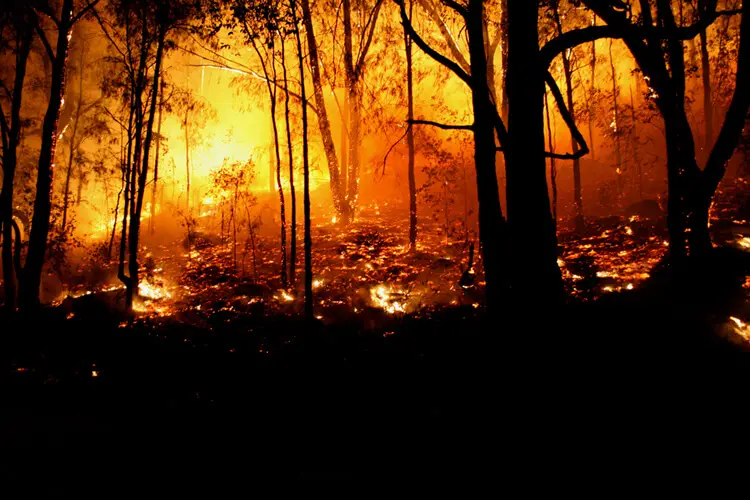
Traditional wine industries have been severely altered by climate change
By 2050, many of the world’s most famous wine-producing areas have been rendered unsuitable for traditional grape growing and winemaking, with climate change having severely impacted land use, agricultural production and species ranges. The area suitable for wine production has declined by almost 85 per cent in some regions. California, Mexico, the eastern USA, Southern Europe, South Africa and Australia are particularly affected.**
In response to the crisis, many traditional vineyards have shifted to higher elevations with cooler conditions – putting pressure on upland ecosystems, as water and vegetation are converted for human use. Others have made use of genetic engineering, or indoor growing methods such as vertical farming. Geoengineering efforts are also getting underway, but have yet to be successful on a global basis.*
Although many regions have been devastated, others have actually benefited. This is particularly noticeable in the Rocky Mountains near the Canadian-US border, the westernmost parts of Russia, and Europe which has seen a massive shift northward in the areas suitable.
Click to view larger version
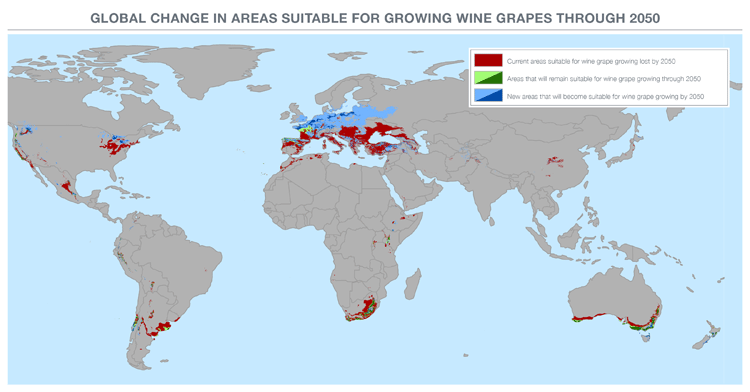
Credit: Conservation International
Fish body size has declined by nearly a quarter
By far the greatest impact from global warming has been in the seas and oceans,* where changes in heat content, oxygen levels and other biogeochemical properties have devastated marine ecosystems. Globally, the average body size of fish has declined by up to 24 per cent compared with 2000.* About half of this shrinkage has come from changes in distribution and abundance, the remainder from changes in physiology. The tropics have been the worst affected regions.
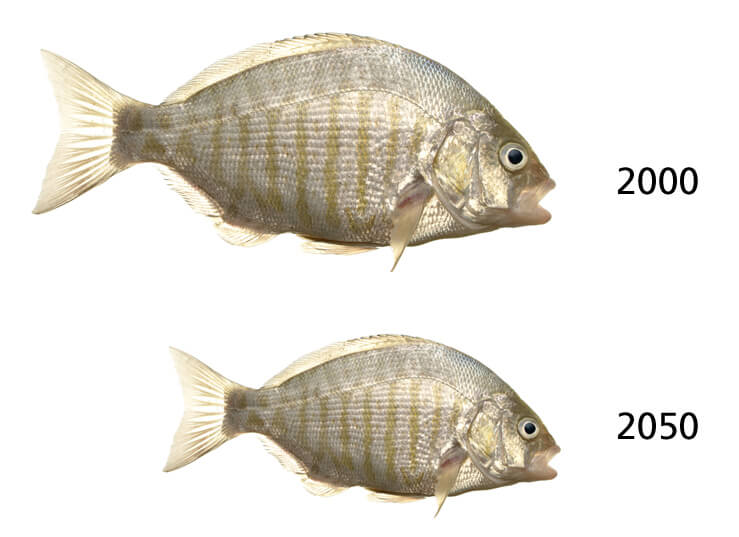
Hi-tech, intelligent buildings are revolutionising the urban landscape
In the first half of the 21st century, a soaring urban population posed serious problems for the environment, health and infrastructure of many cities. In newly industrialised nations especially, urban centres became polluted, overcrowded and chronically inefficient. Throughout the world, metropolitan areas grew to unprecedented sizes – putting huge and increasing pressure on city planners to adapt.*
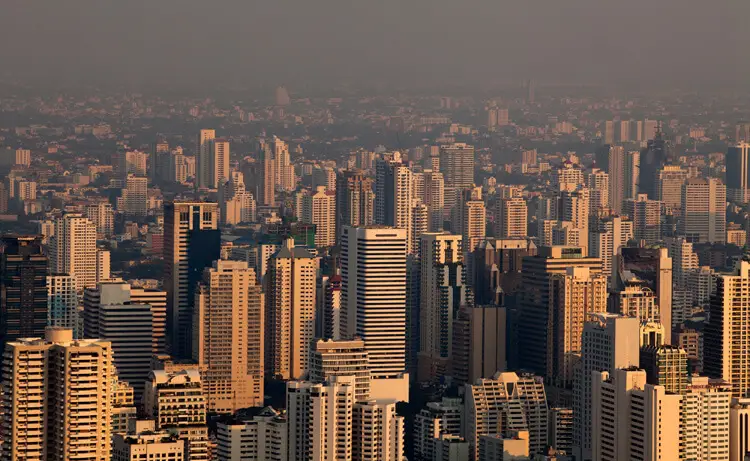
Amid worsening climate change and resource depletion, urban regions were forced to either evolve, or die off. Countless cities failed to make this transition in time, and went the way of Detroit, many being abandoned and left to decay, or subject to intense military control and martial law. In those that survived, a new generation of buildings and infrastructure emerged based on these rapidly changing social and environmental needs.*
Among the most important trends in modern architecture has been self-sufficiency. By 2050, environmental and resource degradation have become so obvious and huge, it has triggered a radical rethink of production and consumption by citizens. As such, many modern skyscrapers now come complete with the internalised creation of food, water and other resources. Farms often comprise multiple floors of a tower – regardless of its purpose – while rain, mist and condensation are constantly trapped and stored. Advanced 3D printers are available locally on site to manufacture everything from household furniture, to personal transportation, to replacement parts for the building itself. Energy is typically provided by photovoltaics and wind turbines. These are often integrated seamlessly into the building design, so as not to harm the aesthetic appeal. Solar power, for instance, can be collected by window panes or special photovoltaic paints applied to outside surfaces.* The efficiencies for solar have been improving steadily for decades.*
Nature features heavily in these structures. Many towers incorporate parks and sky gardens, helping to increase the overall biodiversity of a city, with numerous bird and small animal species finding homes and nesting places. Careful environmental controls ensure that these creatures are protected while not becoming a nuisance for human residents. The outside of buildings are often covered with vegetation, or special membranes, designed to filter pollutants and capture CO2.* Government regulations now require a large percentage of buildings to be fitted in this way, making it a dominant style of architecture today. The artificial parts of this outer layer can also adjust to wind conditions, temperatures, moisture levels and sunlight in order to produce optimal thermal comfort for the human and animal occupants. Algae bio-fuel cells adorning the facade can also absorb CO2 while acting as an additional source of electricity.*

Buildings are integrated into the city around them in a number of ways. Fuel restrictions and other factors have led to increasingly socialised transportation. The bottom floors of most towers have dedicated public car share (AI controlled) and bike share facilities, while bus and other mass transit stations are often built into the structures themselves. Pedestrian sky-walkways feature heavily in most modern cities, improving access and permeability of the urban realm, while shielding walkers from the elements. If ornamented with foliage, they can also function as elevated parks and gardens.
Buildings are making cities more comfortable and inviting in various other ways. By tightly controlling a tower’s reflectivity, heat absorption and heat balance, for example, planners can significantly reduce the temperatures associated with urban heat island effects. This comes at a time when temperatures in less developed cities are soaring from the combined effects of climate change and urbanisation.*
The average modern building in 2050 is seamlessly integrated into a city’s power supply, acting as another node in a city-wide smart grid. Nearly all buildings are able to transmit locally produced energy back into the system. Wireless electricity transfer is also common, with energy beamed invisibly between buildings, which eliminates the need for unsightly poles and cables. AI systems within each building direct its total power consumption, adjusting according to the varying needs of occupants and taking into account even the most minor of details.
Overall, this new smart infrastructure is helping to drastically improve the nature of urban living. Cities following this model are becoming far more liveable, clean, efficient and modernised. Though many regions have collapsed into chaos, others are now leading the way in providing a more sustainable path for humanity.
Smaller,
safer, hi-tech automobiles
Increased
living costs, lifestyle changes and environmental factors have resulted in smaller, more energy-efficient cars that are usually rented on demand rather than owned. More people
than ever before are choosing to live and work alone, while the number
of children per couple has also declined, which is reducing the demand for larger and more expensive vehicles.
Practically all cars in the developed world are now self-driving* and either hybrid or pure electric, while traffic
flow and other road management issues are handled by advanced networks of
AI. The resulting fall in congestion has boosted economies by billions of dollars. Air pollution has also declined greatly.
The inherent
safety of being controlled by machine intelligence, rather than human hands, allows
for greater speed of travel. An increasing number of countries are removing the speed limits on highways. Even when
crashes do occur, which is extremely rare, built-in safety features
and tougher materials (e.g. carbon nanotubes) mean
that fatalities are becoming virtually non-existent.

A typical mid-range car of 2050.
Major
advances in air travel comfort
Commercial airliners of 2050 are safer, quieter and cleaner than those of earlier decades. The vast majority are based on some form of renewable energy. Additionally, travel times have
greatly improved. Hypersonic engines have seen further development, aided by the rapid growth of artificial
intelligence and the resulting advances in computer-automated design evolution.
It is now possible to reach anywhere on the planet in under 2.5 hours.
The interiors
of most planes are breathtakingly luxurious compared to those of earlier
decades. New materials have enabled the use of transparent walls and ceilings,
flooding the fuselage with natural light. Seating areas are beautifully
spacious and filled with a range of interactive technology.
When flights
are running below full capacity, any unneeded seats are automatically shuffled to
the rear, collapsed and hidden from view. The remaining
seats are redistributed, rearranging themselves to offer everyone
the maximum possible legroom. These seats can also morph to perfectly fit passengers’
bodies. They can re-energise travellers with vitamin and antioxidant-enriched
air, mood lighting, aromatherapy and acupressure treatments.* In the mid-section
of the plane is a hi-tech zone offering a range of activities from virtual
golf, to conference facilities and bar/lounge settings.
Recreational marijuana is legal in the majority of countries
In the late 20th and early 21st century, a number of countries began to relax their policies on cannabis. This marked the beginning of a worldwide shift in public and governmental attitudes towards the plant. Factors driving this trend included the historic and ongoing failures of prohibition, improvements in education and scientific research into the drug, greater recognition of the economic and other benefits it could provide, as well as changing voter demographics and a more relaxed approach favoured by younger generations.
During the 2010s, an estimated 3 to 5% of the global population consumed cannabis for medical or recreational purposes, making it by far the most widely used illicit substance. Among all psychoactive drugs, it ranked behind only tobacco and alcohol in popularity.
Although illegal at the federal level, individual states of the United States began to implement their own policy reforms. California had been the first state to legalise medical use of cannabis when voters approved Proposition 215, which passed with 55.6% of the vote in 1996. Many other states followed with decriminalisation and medical legalisation in the late 1990s and 2000s.
Recreational legalisation began in 2012, with Colorado and Washington becoming the first two states allowing cannabis for non-medical uses. A total of 18 states, two territories, and the District of Columbia passed such laws over the next 10 years, with decriminalisation in another 13 states and one territory. By the end of the decade, the United States accounted for 90% of the $10 billion global trade in legal cannabis.
Outside the United States, other major developments occurred during this time. In 2013, Uruguay became the first country to legalise the cultivation, sale, distribution, and consumption of marijuana. By 2022, a total of six countries had legalised recreational use – Canada, Georgia, Malta, Mexico, South Africa, and Uruguay, plus the aforementioned states and territories of the United States, as well as the Australian Capital Territory in Australia.
Contrary to popular belief, recreational marijuana in the Netherlands did not extend to full legality at this time, with consumption and sale instead being tolerated only in licensed coffeeshops alongside the decriminalisation of personal possession.
As the 2020s progressed, the market for medical cannabis saw an eight-fold expansion, from $6.8 billion in 2020, to $53.9 billion by 2030. A majority of the world’s countries had legalised the drug for medical uses by 2028.
Recreational legalisation proved to be a more gradual process, however. Only five countries allowed non-medical use by 2020. Although this figure rose to around 25 by 2030 (including the United States legalising at the federal level), it remained far below the 100+ countries allowing medical use.
Following Mexico in 2021, other countries in Latin America moved to relax their policies too – Argentina, Chile, Colombia, Ecuador, Peru, and Venezuela. About a quarter of countries in Europe reformed their cannabis policies during this decade, mainly in the west of the continent. Australia and New Zealand followed the same trend as their antipodean counterparts. In Africa, somewhat faster changes occurred, led by South Africa, Ghana, Lesotho, Sierra Leone, and Zimbabwe, driven in large part by the “green rush” of economic opportunities.*
The Middle East and most of Asia progressed at a slower rate. Thailand had legalised medical use in 2018 and began moving to full legalisation, while India already maintained a de facto legalisation and tolerance in certain regions. But legalisation at the federal level remained a distant prospect for India. Elsewhere in Asia and the Middle East, many nations held strongly opposing views towards cannabis. Malaysia, for example, imposed a mandatory death penalty for convicted drug traffickers, legally defined as individuals possessing more than 200 g (7 oz) of cannabis. In Japan, public opinion polls showed that less than 15% of people thought the drug should be legally available.
By 2040, the number of countries allowing non-medical use of cannabis had reached 60, with attitudes shifting in many more parts of Europe, as well as Africa and Latin America. Opposition remained strong in the Middle East and Asia, however, despite some progress with decriminalisation and medical use. For a majority of the world’s countries to legalise recreational cannabis, it would take until 2050.*
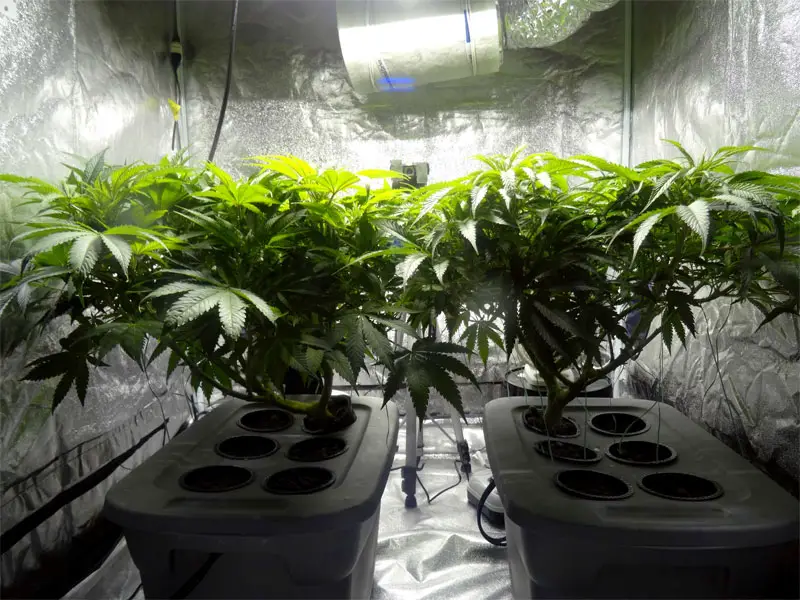
Plantlady223, CC BY-SA 4.0, via Wikimedia Commons
Continent-wide
“supergrids” provide much of the world’s energy needs
The need
for reliable, clean, cost-effective energy has led to the creation of
electrical “supergrids” across much of the world. These allow nations to share power from abundant green sources and distribute
it to those regions most in need. By cooperating in this way, it is
possible to greatly reduce waste and to optimise power supplies
on a continent-wide scale, at all times of the year.
For instance,
winter gales in the North Sea can provide a surplus of wind power, which
is complemented by the summer winds of Morocco and Egypt. Meanwhile,
solar panels in northern Africa generate three times the electricity
compared with the same panels in northern Europe, due to much greater
intensity of sunlight. Up to 100 GW of power is being supplied from
Africa to Europe in this way.* Similar
large-scale infrastructure is now in place throughout America, Asia
and other parts of the world.
Long distance
transmission technology has seen major advances over the decades. Each
country is connected to the grid using high-voltage direct current (HVDC)
transmission, instead of traditional alternating current (AC) lines.
This results in far greater efficiency, since DC lines have much lower
electrical losses over long distances.
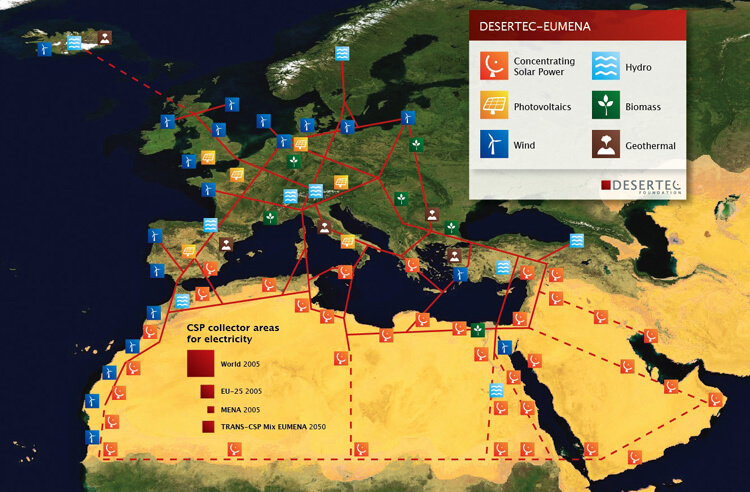
Source: DESERTEC
Foundation
China completes the largest water diversion project in history
The South-North Water Transfer Project – proposed almost a century ago* – is finally completed in China this year* at a cost of over $60 billion.* This becomes the largest project of its kind ever undertaken, stretching thousands of kilometres across the country.
Its main purpose is to divert water from the southern region of China to the dryer north. It is hoped that this will spur economic growth and stability in the more populous northern area, where the per capita share of regional water has declined to near-crisis levels. It consists of an extensive system of tunnels, dams, reservoirs and canals, all connecting and diverting water from China’s largest rivers – including the Yangtze, Yellow and Hai River. At its peak capacity, the entire system can move nearly 45 billion cubic metres of water annually.
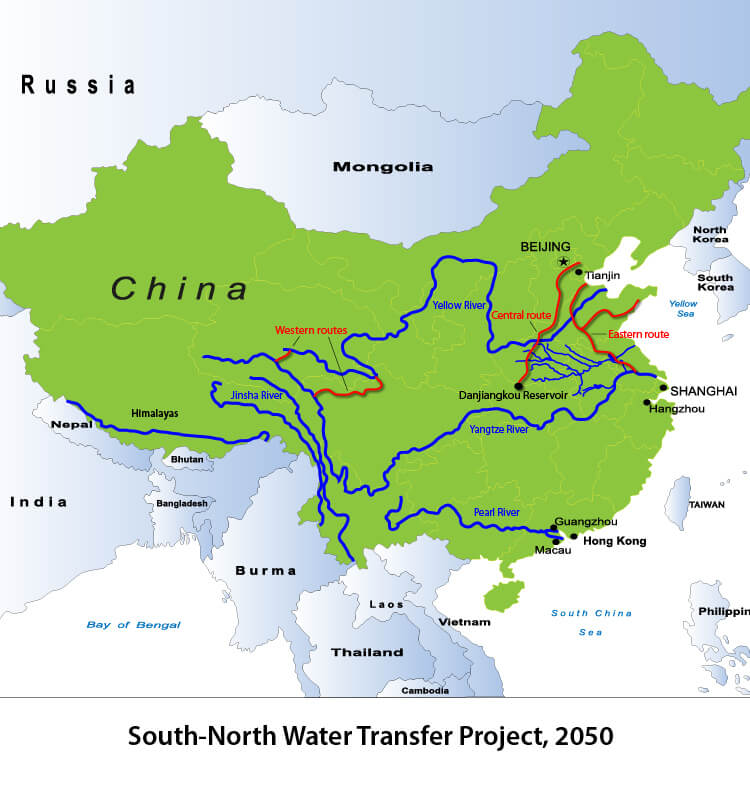
First proposed by Mao Zedong in 1952, the project was officially approved in 2002. The first stage of construction, the 717 mile (1,155 km) long eastern route, was completed in 2013. This begins near the mouth of the Yangtze, crosses through the Yellow River and ends at the Beijing-Tianjin Metropolitan area within the Bohai Economic Rim. This brings much-needed water to one of the largest and most high density conurbations in the world. Along with the construction of new tunnels and pumping stations, the Grand Canal was upgraded in order to accommodate the increased flow of water.* Adding to this is the central route, completed in 2014. This brings water from the Danjiangkou and Three Gorges reservoirs, as well as the Han River, north to Beijing and its neighbouring provinces. This totals 787 miles (1,267 km) in length and by 2030 was diverting over 13 billion cubic metres of water annually. The third and final stage to be completed is the 310 mile (500 km) western route. This involved working on the Qinghai-Tibet Plateau – from 3,000–5,000m above sea level – and posed major engineering and climatic challenges. This route diverts water from the headwaters of the Yangtze to the parched eastern plateaus.
Like the Three Gorges Dam before it, the South-North Water Transfer Project receives heavy criticism.* In addition to environmental damage through mining, construction and pollution, there are worries about the increased potential of floods in certain areas and droughts in others. Also of concern are the hundreds of thousands of people displaced from their homes during construction. Meanwhile, other diversion projects in the south have provoked conflicts with neighbouring countries.*
Many doubted that China had enough water to begin with to make the project worthwhile. Indeed, by the 2050s, southern China itself is beginning to feel the effects of melting Himalayan glaciers and drying conditions. As a result, the water diversion project rarely operates at full capacity, primarily acting as a way to evenly distribute water around China, easing tensions between the inland and coastal regions. While of some benefit to China now, in the coming years, even projects of this magnitude will be insufficient to prevent serious water shortages.* Longer term, only desalination will be able to save the country.
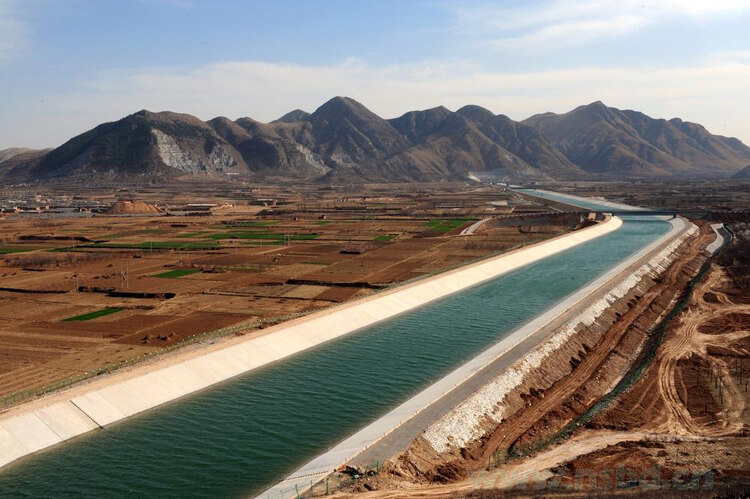
Credit: Bo Song, The Middle Route Project Construction Authority
References
1 The Earth Is a Ponzi Scheme on the Verge of Collapse, AlterNet:
https://www.alternet.org/story/135525/the_earth_is_a_ponzi_scheme_on_the_verge_of_collapse
Accessed 6th May 2012.
2 Earth’s natural wealth: an audit, The Free Range Activism Website (FRAW):
http://www.fraw.org.uk/library/tech/new_scientist_2007.pdf
Accessed 22nd February 2018.
3 Megachange: The World in 2050, The Economist:
http://www.amazon.com/Megachange-The-World-2050-Economist/dp/1118180445/
Accessed 6th May 2012.
4 The Singularity Is Near, Ray Kurzweil:
http://www.amazon.com/The-Singularity-Is-Near-Transcend/dp/0143037889
Accessed 6th May 2012.
5 The Meaning of the 21st Century: A Vital Blueprint for Ensuring Our Future, James Martin:
http://www.amazon.com/The-Meaning-21st-Century-Blueprint/dp/B001G8WI6E
Accessed 6th May 2012.
6 World needs to stabilise population and cut consumption, says Royal Society, The Guardian:
http://www.guardian.co.uk/environment/2012/apr/26/earth-population-consumption-disasters
Accessed 6th May 2012.
7 The End of Growth: Adapting to Our New Economic Reality, Richard Heinberg:
http://www.amazon.com/The-End-Growth-Adapting-Economic/dp/0865716951
Accessed 6th May 2012.
8 Peter Joseph Radio Lecture “A Profile of Collapse”, The Zeitgeist Movement:
https://www.youtube.com/watch?v=Bil6ZTEvC8M
Accessed 6th May 2012.
9 S&P: 60% of countries will be bankrupt within 50 years, Raw Story:
http://www.rawstory.com/rs/2010/10/09/sp-60-countries-bankrupt-50-years/
Accessed 6th May 2012.
10 Technological singularity, Wikipedia:
http://en.wikipedia.org/wiki/Technological_singularity
Accessed 6th May 2012.
11 S&P: 60% of countries will be bankrupt within 50 years, Raw Story:
http://www.rawstory.com/rs/2010/10/09/sp-60-countries-bankrupt-50-years/
Accessed 6th May 2012.
12 S&P: 60% of countries will be bankrupt within 50 years, Raw Story:
http://www.rawstory.com/rs/2010/10/09/sp-60-countries-bankrupt-50-years/
Accessed 6th May 2012.
13 Megachange: The World in 2050, The Economist:
http://www.amazon.com/Megachange-The-World-2050-Economist/dp/1118180445/
Accessed 6th May 2012.
14 See 2055.
15 The End of Growth: Adapting to Our New Economic Reality, Richard Heinberg:
http://www.amazon.com/The-End-Growth-Adapting-Economic/dp/0865716951
Accessed 6th May 2012.
16 Bitcoin, Wikipedia:
http://en.wikipedia.org/wiki/Bitcoin
Accessed 6th May 2012.
17 World Population Ageing, UN:
http://www.un.org/esa/population/publications/WPA2009/WPA2009-report.pdf
Accessed 6th May 2012.
18 Spending for seniors to double or more by 2050, European Commission:
https://ec.europa.eu/digital-single-market/en/news/spending-seniors-double-or-more-2050
Accessed 3rd January 2018.
19 Global warming could create 150 million ‘climate refugees’ by 2050, The Guardian:
http://www.guardian.co.uk/environment/2009/nov/03/global-warming-climate-refugees
Accessed 6th May 2012.
20 Animating water bottle recycling rates, Doug James, Cornell University:
https://www.youtube.com/watch?v=OZbTXDkrD1o
Accessed 6th May 2012.
21 Rising resource use threatens future growth, warns UN, BBC:
http://www.bbc.co.uk/news/science-environment-13376416
Accessed 6th May 2012.
22 The Story of Stuff:
http://www.storyofstuff.org/movies-all/story-of-stuff/
Accessed 6th May 2012.
23 Planned obsolescence, Wikipedia:
http://en.wikipedia.org/wiki/Planned_obsolescence
Accessed 6th May 2012.
24 Rising resource use threatens future growth, warns UN, BBC:
http://www.bbc.co.uk/news/science-environment-13376416
Accessed 6th May 2012.
25 See Personal service robot population, 2000-2050.
26 The Lights in the Tunnel, Martin Ford:
http://www.thelightsinthetunnel.com/
Accessed 6th May 2012.
27 The 3D Printing Revolution, Explaining the Future:
http://www.youtube.com/watch?v=CP1oBwccARY&hd=1
Accessed 6th May 2012.
28 Nuclear bomb material found for sale on Georgia black market, The Guardian:
http://www.guardian.co.uk/world/2010/nov/07/nuclear-material-black-market-georgia?CMP=twt_fd
Accessed 6th May 2012.
29 Europe’s Roadmap to Low Carbon by 2050, LessEn:
http://www.less-en.org/?page=blog&article=108
Accessed 6th May 2012.
30 Poll: 75 Percent of Americans Support Regulating CO2 As A Pollutant, 60 Percent Support Revenue-Neutral Carbon Tax, Think Progress:
http://thinkprogress.org/climate/2012/04/26/471840/poll-75-of-americans-support-co2-regulation-60-support-revenue-neutral-carbon-tax/
Accessed 6th May 2012.
31 Solar power could surge by 2050 in deserts: study, Reuters:
http://www.reuters.com/article/2009/05/25/us-solar-idUSTRE54O16R20090525
Accessed 6th May 2012.
32 See 2032.
33 Peak oil, Wikipedia:
https://en.wikipedia.org/wiki/Peak_oil
Accessed 14th December 2015.
34 Scientists wary of shale oil and gas as U.S. energy salvation, Future Timeline blog:
https://www.futuretimeline.net/blog/2013/10/29.htm
Accessed 14th December 2015.
35 See 2040.
36 See 2041.
37 World headed for irreversible climate change in five years, IEA warns, The Guardian:
http://www.guardian.co.uk/environment/2011/nov/09/fossil-fuel-infrastructure-climate-change
Accessed 6th May 2012.
38 Global sea level linked to global temperature, Proceedings of the National Academy of Sciences (PNAS):
http://www.pnas.org/content/106/51/21527.full.pdf
Accessed 6th May 2012.
39 A way to reverse global warming – study finds room to store CO2 underground, FutureTimeline blog:
http://futuretimeline.wordpress.com/2012/03/21/a-way-to-reverse-global-warming-study-finds-room-to-store-co2-underground/
Accessed 6th May 2012.
40 Climate change solutions: freight containers and giant fly-swats, Institution of Mechanical Engineers:
https://www.imeche.org/news/news-article/11-08-22/Climate_change_solutions_freight_containers_and_giant_fly-swats.aspx
Accessed 3rd January 2018.
41 Modelling conservation in the Amazon basin, Nature:
http://www.nature.com/nature/journal/v440/n7083/full/nature04389.html
Accessed 6th May 2012.
42 Wildfires
set to increase 50 percent by 2050, Science Centric:
http://www.sciencecentric.com/news/article.php?q=09072853-wildfires-set-increase-50-percent-by-2050
Accessed 1st May 2010.
43 Environmentalists
say Greece disregarded climate change, EurActiv:
https://www.euractiv.com/section/climate-environment/news/environmentalists-say-greece-disregarded-climate-change/
Accessed 1st May 2010.
44 Climate change will threaten wine production, study shows, The Guardian:
http://www.guardian.co.uk/environment/2013/apr/08/climate-change-wine-production
Accessed 21st April 2013.
45 Climate change, wine, and conservation, Lee Hannah et al:
http://www.conservation.org/Documents/CI_PNAS_Climate-Change-Wine-Production-Conservation_Lee-Hannah_March-2013.pdf
Accessed 21st April 2013.
46 See 2060-2100.
47 Change in Earth’s total heat content, Skeptical Science:
http://www.skepticalscience.com/graphics.php?g=46
Accessed 1st October 2012.
48 Shrinking of fishes exacerbates impacts of global ocean changes on marine ecosystems, Nature Climate Change:
http://www.nature.com/nclimate/journal/vaop/ncurrent/full/nclimate1691.html
Accessed 1st October 2012.
49 See 2030.
50 Report describes the future of buildings in 2050, Future Timeline Blog:
https://www.futuretimeline.net/blog/2013/02/14.htm
Accessed 10th March 2013.
51 Paint-on solar cells developed, Future Timeline Blog:
https://www.futuretimeline.net/blog/2011/12/23.htm
Accessed 10th March 2013.
52 Best Research Cell Efficiences, NREL:
http://www.nrel.gov/ncpv/images/efficiency_chart.jpg
Accessed 10th March 2013.
53 Potential carbon capture role for new CO2 absorbing material, Future Timeline Blog:
https://www.futuretimeline.net/blog/2012/06/12.htm
Accessed 10th March 2013.
54 Ecological Age Presentation, Arup:
http://www.youtube.com/watch?v=EbNuU21_V8I#t=5m24s
Accessed 10th March 2013.
55 City Temps May Soar From Urbanization, Global Warming, Climate Central:
http://www.climatecentral.org/news/urbanization-global-warming-could-send-city-temps-soaring-14806
Accessed 10th March 2013.
56 You won’t need a driver’s license by 2040, CNN:
http://edition.cnn.com/2012/09/18/tech/innovation/ieee-2040-cars/index.html
Accessed 1st October 2012.
57 Airbus
presents a panoramic view of 2050, Airbus:
http://www.airbus.com/newsevents/news-events-single/detail/airbus-presents-a-panoramic-view-of-2050/
Accessed 15th June 2011.
58 These are the Countries Most Likely to Legalize Weed Next, Vice:
https://www.vice.com/en/article/gy4pa7/these-are-the-countries-most-likely-to-legalize-weed-next
Accessed 3rd April 2022.
59 Extrapolated from the graph at 2028.
60 Saharan
sun to power European supergrid, The Guardian:
http://www.guardian.co.uk/environment/2008/jul/22/solarpower.windpower
Accessed 11th October 2009.
61 China Completes Tunnel Under Yellow River for South-North Water Transfer Project, Circle of Blue:
http://www.circleofblue.org/waternews/2012/world/update-china-completes-tunnel-under-yellow-river
Accessed 17th June 2012.
62 South-to-North Water Diversion Project, China, water-technology.net:
http://www.water-technology.net/projects/south_north/
Accessed 17th June 2012.
63 Water Wars, China Water Risk:
http://chinawaterrisk.org/big-picture/water-wars/
Accessed 17th June 2012.
64 Grand Canal (China) – South-North Water Transfer Project, Wikipedia:
http://en.wikipedia.org/wiki/Grand_Canal_of_China#South-North_Water_Transfer_Project
Accessed 17th June 2012.
65 Plan for China’s Water Crisis Spurs Concern, New York Times:
http://www.nytimes.com/2011/06/02/world/asia/02water.html?_r=1&pagewanted=all
Accessed 17th June 2012.
66 Geopolitical Risks: Transboundary Rivers, China Water Risk:
http://chinawaterrisk.org/resources/analysis-reviews/geopolitical-risks-transboundary-rivers/
Accessed 17th June 2012.
67 The key effects of climate change: How water availability may change, as temperatures, population and industrialisation increase, BBC:
http://news.bbc.co.uk/1/hi/sci/tech/7821082.stm
Accessed 17th June 2012.